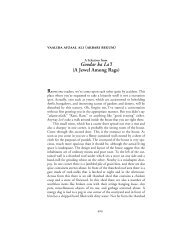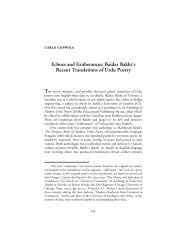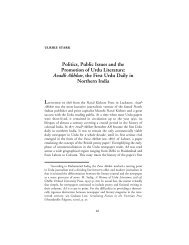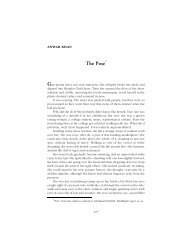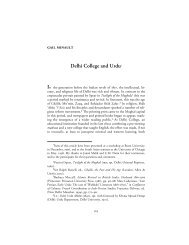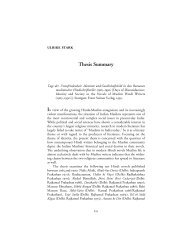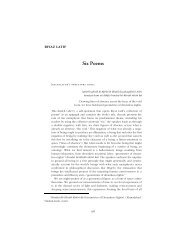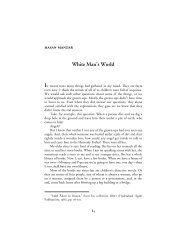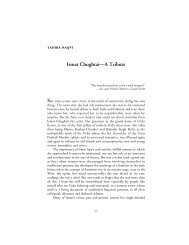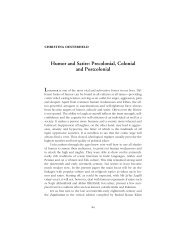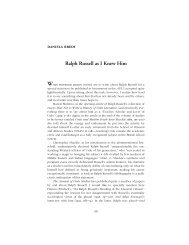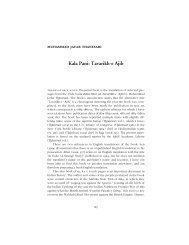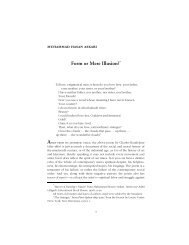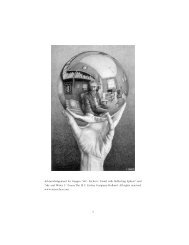Premchand's âShatranj ke Khilariâ in Translation - the Annual of Urdu ...
Premchand's âShatranj ke Khilariâ in Translation - the Annual of Urdu ...
Premchand's âShatranj ke Khilariâ in Translation - the Annual of Urdu ...
Create successful ePaper yourself
Turn your PDF publications into a flip-book with our unique Google optimized e-Paper software.
202 • The <strong>Annual</strong> <strong>of</strong> <strong>Urdu</strong> Studies, No. 28<br />
sage by <strong>in</strong>troduc<strong>in</strong>g <strong>the</strong> device <strong>of</strong> <strong>the</strong> narrator. As an authorial <strong>in</strong>trusion, <strong>the</strong><br />
narrator here serves as <strong>the</strong> authorís mouthpiece, deconstruct<strong>in</strong>g for <strong>the</strong><br />
reader both <strong>the</strong> protagonists and <strong>the</strong>ir sociocultural milieu mostly through<br />
<strong>the</strong> use <strong>of</strong> irony and satire. In <strong>the</strong>se narrative comments, Premchandís H<strong>in</strong>di<br />
is Sanskritic and his tone, condemnatory.<br />
Later, he rewrites <strong>the</strong> same story <strong>in</strong> heavily Persianized <strong>Urdu</strong> as ìSha-<br />
ranj kī Bāzīî to ma<strong>ke</strong> it accessible to an élitist, <strong>Urdu</strong> readership. This selftranslational<br />
exercise, as most o<strong>the</strong>rs, contributes toward a reestablishment<br />
<strong>of</strong> <strong>the</strong> cultural and l<strong>in</strong>guistic hegemony <strong>of</strong> <strong>the</strong> deposed power center <strong>of</strong><br />
<strong>Urdu</strong> with<strong>in</strong> l<strong>in</strong>guistically and culturally pluralistic nor<strong>the</strong>rn India. Functionally,<br />
Premchandís self-translation is a special k<strong>in</strong>d <strong>of</strong> renewal which<br />
enables <strong>the</strong> text to be read by ano<strong>the</strong>r large group <strong>of</strong> peopleó<strong>the</strong> coded<br />
text is recoded and re<strong>in</strong>terpreted. Rewrit<strong>in</strong>g <strong>the</strong> story <strong>in</strong> <strong>the</strong> language<br />
employed by Mīr and Mirzā <strong>in</strong> <strong>the</strong> predom<strong>in</strong>antly élitist cultural center <strong>of</strong><br />
Lucknow differentiates Premchandís story l<strong>in</strong>guistically and aes<strong>the</strong>tically<br />
from <strong>the</strong> earlier Sanskritic H<strong>in</strong>di one. Premchand has his prospective<br />
readership <strong>in</strong> m<strong>in</strong>d. His Persianized <strong>Urdu</strong> becomes as much a medium for<br />
<strong>the</strong> representation <strong>of</strong> cultural patterns as <strong>the</strong> Sanskritic H<strong>in</strong>di is a medium<br />
for critical realism. ìSharanj kī Bāzīî is, <strong>in</strong> fact, a transcreational exercise<br />
where<strong>in</strong> Premchand describes his protagonists and sett<strong>in</strong>g <strong>in</strong> greater detail;<br />
a h<strong>in</strong>t <strong>of</strong> a lament is discernable for both <strong>the</strong> protagonists and <strong>the</strong> pass<strong>in</strong>g<br />
away <strong>of</strong> a social order. His narrator re-narrates with reduced tonal acerbity<br />
and mellowed sarcasm. His political message is veiled; its vigor and ironic<br />
<strong>in</strong>tent seem dim<strong>in</strong>ished. It may be debated that <strong>the</strong> multiple semantic<br />
possibilities <strong>of</strong> <strong>the</strong> Persianized <strong>Urdu</strong> vocabulary employed by <strong>the</strong> author<br />
actually provide for <strong>the</strong> multiple connotative possibilities conta<strong>in</strong>ed <strong>in</strong> <strong>the</strong><br />
text and contribute to <strong>the</strong> veil<strong>in</strong>g.<br />
Premchandís altered <strong>Urdu</strong> title ìSharanj kī Bāzīî seems <strong>in</strong>appropriate<br />
when viewed, firstly, <strong>in</strong> <strong>the</strong> light <strong>of</strong> <strong>the</strong> holistic message conveyed by <strong>the</strong><br />
H<strong>in</strong>di text; secondly, because <strong>the</strong> replacement <strong>of</strong> <strong>the</strong> orig<strong>in</strong>al ìkẖilāṛīî with<br />
ìbāzīî shifts <strong>the</strong> focus from <strong>the</strong> chess-players to <strong>the</strong> game <strong>of</strong> chess, or <strong>the</strong><br />
moves made by <strong>the</strong> players dur<strong>in</strong>g <strong>the</strong> course <strong>of</strong> <strong>the</strong> game; and thirdly,<br />
because <strong>the</strong> word ìkẖilāṛīî (player/players), common to both <strong>Urdu</strong> and<br />
H<strong>in</strong>di, carries similar semantic connotations and can be nuanced with similar<br />
ironic overtones. However, consider<strong>in</strong>g that <strong>the</strong> <strong>Urdu</strong> narratorís criticism<br />
<strong>of</strong> <strong>the</strong> society and castigation <strong>of</strong> <strong>the</strong> players is m<strong>in</strong>gled with a lament for<br />
both, and also seems to conclude on a philosophical note bemoan<strong>in</strong>g <strong>the</strong><br />
fate <strong>of</strong> <strong>the</strong> players <strong>in</strong> meet<strong>in</strong>g <strong>the</strong>ir unnatural deaths and <strong>the</strong> pass<strong>in</strong>g away<br />
<strong>of</strong> an old order, <strong>the</strong> title seems consistent with <strong>the</strong> substance <strong>of</strong> <strong>the</strong> narrative.<br />
The dilapidated mosque, supposedly built dur<strong>in</strong>g <strong>the</strong> reign <strong>of</strong> Āṣafuíd-<br />
Daulah, symbolizes <strong>the</strong> old order, which comb<strong>in</strong>ed with<strong>in</strong> itself <strong>the</strong> dichot-



